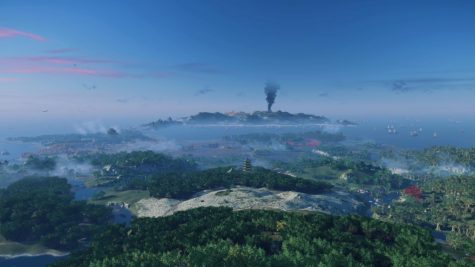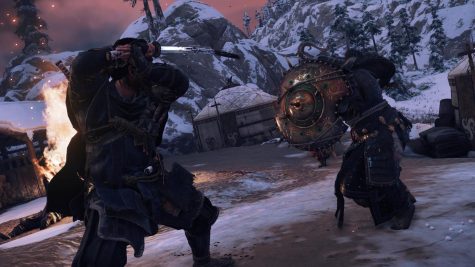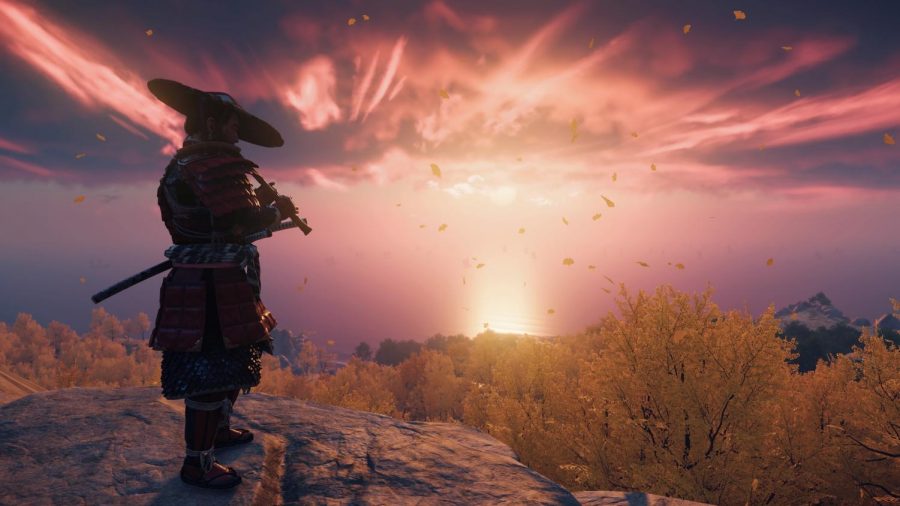Ghost of Tsushima Director’s Cut: new take on open world
Ghost of Tsushima is an open-world, action-adventure video game, developed by Sucker Punch Productions, that was originally released on July 17, 2020, exclusively for the PlayStation 4. On August 20, 2021, the game was remastered for the PlayStation 5 and featured new additional content. This new and improved version of the game was deemed Ghost of Tsushima Director’s Cut.
The game follows Jin Sakai, one of the only Samurai left on the island of Tsushima (a small island in between Korea and Japan), after the Mongol invasion of the island in 1274. Jin must learn to overcome the unknown danger presented by the invaders, by changing his tactics to ones that he would never have used before. Jin is the nephew of Lord Shimura, the Jito of the island. The Jito is the leader of Tsushima, which is appointed by the Shogun of Japan, and the leader of the islands Samurai. The Samurai follow a code of honor, in which they treat their enemies with respect, and never use “dishonorable” tactics when fighting. After most of the Samurai were killed, and Lord Shimura was captured during the Mongol’s initial invasion, Jin has to put this code of honor aside in order to save the island, by any means necessary.
The director’s cut of the game also includes a second story, which takes place on the island Iki, a smaller island to the Southeast of Tsushima. The story involves Jin traveling to the island to stop the Mongols that have now invaded that island, but upon getting there, he uncovers secrets about his family’s past.
The stories of the game perfectly capture how historical figures can become myths or legends. By the end of the game, Jin Sakai completely embraces the legend that he has created, known as the Ghost. The way the people react and spread the story is very reminiscent of modern and ancient legends. There are points in the game where citizens of Tsushima can be heard telling stories of “The Ghost,” where they claim Jin can do superhuman feats such as fly, or kill a man by just looking at him. Actively hearing Jin’s actions throughout the story being turned into folk-tales, makes the player feel powerful and influential, and that’s a feeling many games cannot capture nearly as well as this one has.
Similar to the narrative of the story, the actual gameplay itself takes inspiration from many sources. The most obvious place to notice this is in the stealth gameplay. The basic ideas the game uses come from the Assassin’s Creed game series. It takes the idea of being a stealth-oriented character from these games but improves the mechanics, and narrative behind it.

The exploration aspect of the game also takes inspiration from many others, but it completely mixes up the usual formula. Instead of the typical mini-maps and waypoints of many open-world games, Ghost of Tsushima uses parts of nature to physically guide the player. This makes exploring the island of Tsushima an invigorating experience because it feels like you casually stumble across things in the world.

The most important aspect of the gameplay, is the combat. Obviously, a game about Samurai is going to involve a lot of sword fighting, and the game does it perfectly. Based on what weapon your opponent is using, the player can change the sword technique, or “stance” Jin is using. The stances consist of the stone stance, to combat against swords, the water stance, to combat shields, the wind stance, to combat spears, and finally the moon stance to combat against brutes, which are large, dangerous enemies. This innovative system of switching how you fight on the fly makes the combat very difficult to get good at, but once you master it, you can cut through your enemies like butter.
The only glaring problem with the game is that a lot of the content that fills the open world is somewhat underwhelming. Some objectives are as simple as grabbing a sword or even taking a bath. While these events are interesting the first few times they can be found, there is a vast amount of them, and they get stale fast.
The final aspect of the game is the online mode called Ghost of Tsushima: Legends. This part of the game allows multiple players to join forces and fight off the Mongols, in various game modes that are all a joy to play. The story of the mode is based on ancient legends rather than history, which made it a change of pace compared to the game’s story mode. The main problem with the online mode is how the progression works. It can be tiresome to level up your character, and the layout can be confusing.
Ghost of Tsushima is one of the best games to come out recently, and Ghost of Tsushima Director’s Cut is the definitive way to play it. The game is great for anyone who loves games based on history, games with fantastic open worlds and combat, and games with deep, well-written stories. Ghost of Tsushima Director’s Cut is available on PlayStation 4 and 5 and will be coming to PC soon.

My name is Eddie Drinkwine, I am a senior, and I am the Entertainment section editor for the Guilford Voyager. I’ve always loved writing, and the...
















